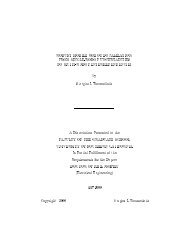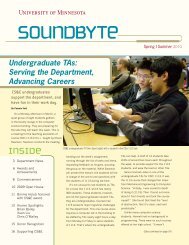40 Years - Computer Science and Engineering - University of ...
40 Years - Computer Science and Engineering - University of ...
40 Years - Computer Science and Engineering - University of ...
Create successful ePaper yourself
Turn your PDF publications into a flip-book with our unique Google optimized e-Paper software.
ajanta<br />
Pr<strong>of</strong>essor An<strong>and</strong> Tripathi <strong>and</strong> doctoral student Neeran Karnik (Ph.D. ’98) created Ajanta, a<br />
Java-based system for programming secure mobile agent-based applications over the Internet.<br />
A mobile agent is a transportable program in the network capable <strong>of</strong> migrating autonomously<br />
from node to node, performing computational tasks on behalf <strong>of</strong> a user. The Ajanta system<br />
provides mechanisms for secure <strong>and</strong> robust transportation <strong>and</strong> execution <strong>of</strong> mobile agents<br />
in the network. A few hundred researchers throughout the world have acquired the Ajanta<br />
system. It has been used for supporting research projects in network monitoring, pervasive<br />
computing, distributed collaboration systems, <strong>and</strong> active networking.<br />
cluto<br />
Pr<strong>of</strong>essor George Karypis created CLUTO, a s<strong>of</strong>tware package licensed by the <strong>University</strong><br />
for data mining, clustering datasets <strong>of</strong> varying dimensions, <strong>and</strong> analyzing the characteristics<br />
<strong>of</strong> clustered data. CLUTO has three different classes <strong>of</strong> clustering algorithms <strong>and</strong> provides<br />
tools for analyzing the clusters to better underst<strong>and</strong> the different clusters <strong>and</strong> the relationships<br />
between the data assigned to each cluster. Since its release in 2002, CLUTO has<br />
become one <strong>of</strong> the most widely used s<strong>of</strong>tware packages for clustering, especially for domains<br />
such as text mining <strong>and</strong> market basket analysis.<br />
intelligent storage<br />
The <strong>University</strong>’s Digital Technology Center Intelligent Storage Consortium (DISC), led by<br />
Pr<strong>of</strong>essor David Du, addresses problems related to the architecture <strong>and</strong> application <strong>of</strong> largescale,<br />
distributed storage systems. This premier research center brings together academia,<br />
industry, <strong>and</strong> public sector agencies to conduct advanced research with practical applications.<br />
DISC members have developed intelligent storage technologies, whereby networked<br />
devices have the ability to recognize, categorize, <strong>and</strong> modify locally stored data. These<br />
technologies translate to faster data retrieval from a more automated interface at lower<br />
cost. The group’s key CSE participants include Pr<strong>of</strong>essors Yongdae Kim, Jon Weissman,<br />
<strong>and</strong> Mohamed Mokbel.<br />
planning an escape<br />
Pr<strong>of</strong>essor Shashi Shekhar <strong>and</strong> his students developed the Capacity Constrained Route<br />
Planner (CCRP) algorithms <strong>and</strong> Web-based s<strong>of</strong>tware to identify routes <strong>and</strong> schedules to<br />
quickly move a large population <strong>of</strong> people either in or out <strong>of</strong> an area. Shekhar <strong>and</strong> his students<br />
used this CCRP methodology to help the Minnesota Department <strong>of</strong> Transportation<br />
0<br />
(MnDoT) prepare evacuation plans for the Twin Cities in<br />
2005. In one example, Shekhar worked out an evacuation<br />
plan for the Monticello, Minn. nuclear power plant – the<br />
hypothetical disaster being an attack on the plant. The plan<br />
identified evacuation routes through nearby highways that<br />
limited congestion.<br />
pddp: scalable clustering s<strong>of</strong>tware<br />
In 1998, Pr<strong>of</strong>essor Daniel Boley developed Principal Direction<br />
Divisive Partitioning (PDDP), a portable s<strong>of</strong>tware package<br />
for unsupervised data mining. This fast, scalable approach<br />
can find unanticipated groupings within very large data sets.<br />
The s<strong>of</strong>tware has been acquired by hundreds <strong>of</strong> users all<br />
over the world, <strong>and</strong> has been used in many applications from<br />
forest-cover satellite data, to toxicology prediction for commercial<br />
chemicals, to an analysis <strong>of</strong> the alcohol laws in all 50<br />
United States.<br />
bringing the scout to the military<br />
<strong>and</strong> beyond<br />
Pr<strong>of</strong>essor Nikolaos Papanikolopoulos developed the COTS-<br />
Scout robot with his students in 2002. The cylindrical, pintsized<br />
robot can be thrown into hazardous environments <strong>and</strong><br />
move around to provide visual feedback to a remote operator.<br />
Currently used by the military in reconnaissance missions,<br />
this technology puts robots, not soldiers, in harms<br />
way to gather visual intelligence. Manufactured from inexpensive,<br />
commercial <strong>of</strong>f-the-shelf (COTS) components, the<br />
COTS-Scout is a high-tech, low-cost version <strong>of</strong> the original<br />
<strong>University</strong> Scout developed in 1999 in cooperation with other<br />
CSE faculty <strong>and</strong> local industries. In 2006, Papanikolopoulos<br />
<strong>and</strong> students founded the company Recon Robotics, making<br />
the COTS-Scout commercially available to military, police,<br />
<strong>and</strong> security agencies.




